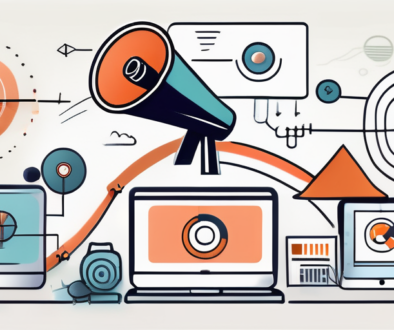B2B Content Distribution: What’s the Best Approach?
In the world of B2B marketing, content distribution plays a crucial role in reaching and engaging the target audience. To truly unlock the potential of your content and maximize its impact, it is essential to understand the intricacies of B2B content distribution. This ultimate guide will provide you with a comprehensive overview, strategies, and insights to navigate the landscape of B2B content distribution successfully.
Understanding B2B Content Distribution
Before diving into the strategies and tools, let’s first define what B2B content distribution is and why it is so important. B2B content distribution refers to the process of disseminating and promoting your content across various channels to reach your target audience. It involves the strategic selection and deployment of channels, platforms, and tactics to ensure maximum visibility and engagement.
Defining B2B Content Distribution
At its core, B2B content distribution is about delivering valuable content to the right people, at the right time, and in the right format. It goes beyond merely creating great content; it is about making sure that your target audience can discover and consume it effectively.
The Importance of B2B Content Distribution
Effective content distribution is crucial for several reasons. Firstly, it helps increase brand awareness and visibility among your target audience. By distributing your content through various channels, such as social media platforms, industry forums, and email newsletters, you can reach a wider audience and position your brand as a thought leader in your industry.
For example, let’s say you are a software company that specializes in providing solutions for the healthcare industry. By distributing informative blog posts, whitepapers, and case studies through healthcare-focused websites, online communities, and professional networks, you can establish your brand as a trusted source of knowledge and expertise in the healthcare technology space.
Secondly, content distribution allows you to generate qualified leads and drive conversions. By ensuring that your content is in front of the right people, you can attract and engage prospects who are more likely to convert into paying customers. This can be achieved through targeted advertising, content syndication, and strategic partnerships.
For instance, you can collaborate with industry influencers or partner with complementary businesses to amplify the reach of your content. By leveraging their existing networks and credibility, you can tap into new audiences and increase the chances of converting them into leads or customers.
Lastly, B2B content distribution enables you to build and nurture relationships with your audience. By consistently delivering valuable content, you can establish trust, credibility, and loyalty, which are crucial for long-term success. This can be achieved through personalized email campaigns, interactive webinars, and engaging social media interactions.
For example, you can create a series of educational videos or webinars that address common pain points or challenges faced by your target audience. By providing practical solutions and actionable insights, you can position your brand as a trusted advisor and build strong relationships with your audience.
In conclusion, B2B content distribution is not just about creating great content; it is about strategically disseminating and promoting that content to reach your target audience effectively. By leveraging various channels, platforms, and tactics, you can increase brand awareness, generate qualified leads, and build long-term relationships with your audience. So, take the time to plan and execute a comprehensive content distribution strategy that aligns with your business goals and objectives.
The Landscape of B2B Content Distribution
Now that we have a clear understanding of what B2B content distribution entails, let’s explore the landscape and the key players shaping it.
When it comes to B2B content distribution, several key players dominate the scene. These include social media platforms, search engines, email marketing platforms, content syndication networks, and industry-specific platforms.
Social media platforms such as LinkedIn, Twitter, and Facebook allow you to reach a large audience and engage with them directly. They offer a range of targeting options and advertising features to help you amplify your content reach.
Search engines like Google and Bing play a crucial role in content discovery. Optimizing your content for search engines with relevant keywords and meta tags can greatly improve your visibility and organic traffic.
Email marketing platforms enable you to distribute your content directly to your subscribers’ inboxes. By crafting compelling email campaigns, you can nurture leads and drive engagement with your content.
Content syndication networks like Outbrain and Taboola allow you to distribute your content on high-traffic websites. They use native advertising to promote your content in a non-intrusive manner, reaching a wider audience beyond your owned channels.
Industry-specific platforms, such as relevant online communities and forums, trade publications, and industry association websites, provide targeted distribution opportunities to reach niche audiences.
But what does the future hold for B2B content distribution? Let’s take a look at some emerging trends that are shaping the landscape.
Emerging Trends in B2B Content Distribution
B2B content distribution is constantly evolving, driven by emerging trends and technologies. Understanding and adapting to these trends can give you a competitive edge. Some notable trends include:
- The rise of video content: Video content continues to gain popularity, offering engaging and immersive experiences. Platforms like YouTube and LinkedIn Video provide opportunities to distribute and promote your video content.
- The power of influencer marketing: Collaborating with industry influencers allows you to tap into their established audience and credibility. Influencers can help amplify your content reach and generate valuable engagement.
- Personalization and automation: Tailoring your content distribution efforts to individual preferences and automating the process can significantly improve efficiency and effectiveness.
- Micro-targeting and account-based marketing (ABM): Zeroing in on specific target accounts and delivering personalized content can yield higher engagement and conversion rates.
These trends are reshaping the B2B content distribution landscape, providing new opportunities for businesses to connect with their target audience. By staying informed and adapting to these trends, you can ensure that your content reaches the right people at the right time, maximizing its impact and driving meaningful results.
Strategies for Effective B2B Content Distribution
Now that we have explored the landscape, let’s dive into some strategies to optimize your B2B content distribution efforts.
When it comes to identifying your target audience, it’s crucial to go beyond surface-level demographics. Dive deep into understanding the psychographics of your audience – their values, beliefs, and motivations. By developing detailed buyer personas based on this information and conducting thorough market research, you can tailor your content and distribution channels to not just meet but exceed their needs.
Creating high-quality content is not just about ticking off boxes; it’s about creating a memorable experience for your audience. Invest time and resources in crafting content that is not only valuable and relevant but also emotionally resonant. By addressing the pain points of your audience in a compelling way, you can establish a strong connection that goes beyond a simple transaction.
Identifying Your Target Audience
The first step in effective content distribution is understanding your target audience. Who are they? What challenges do they face? What type of content resonates with them? By developing buyer personas and conducting thorough market research, you can tailor your content and distribution channels to meet their needs.
Creating High-Quality Content
No matter how well you distribute your content, if it lacks quality, it won’t yield the desired results. Invest in creating valuable, relevant, and well-crafted content that addresses the pain points of your audience. Quality content not only attracts attention but also encourages sharing and engagement.
Leveraging Social Media for Distribution
Social media platforms offer immense opportunities for content distribution. Develop a comprehensive social media strategy that aligns with your business goals. Create shareable content, engage with your audience, and leverage paid advertising options to extend your reach and boost engagement.
When it comes to leveraging social media for distribution, it’s not just about being present on every platform; it’s about being strategic. Identify the social media channels where your target audience is most active and tailor your content to suit each platform’s unique characteristics. By understanding the nuances of each platform and optimizing your content accordingly, you can maximize your reach and engagement.
Measuring the Success of Your B2B Content Distribution
As with any marketing effort, it is essential to measure and evaluate the success of your B2B content distribution. This allows you to optimize your strategies and make data-driven decisions.
Understanding the impact of your content distribution efforts goes beyond merely creating and sharing content. It involves delving into the analytics and key performance indicators (KPIs) to gain valuable insights into how your target audience is engaging with your content.
Key Performance Indicators (KPIs) for Content Distribution
Some important KPIs to consider when evaluating your content distribution success include:
- Website traffic: Analyze the volume and sources of traffic to gauge the effectiveness of your distribution efforts.
- Engagement metrics: Monitor metrics like time on page, bounce rate, and social shares to assess how well your content is resonating with your audience.
- Conversion rates: Track the number of leads generated and conversions achieved through your content distribution channels.
- ROI: Calculate the return on investment for your content distribution efforts to determine their overall impact on your business goals.
By closely monitoring these KPIs, you can gain a comprehensive understanding of the strengths and weaknesses of your content distribution strategy. This data-driven approach enables you to make informed decisions and refine your tactics for better results.
Tools for Tracking B2B Content Distribution Success
Thankfully, there are numerous tools available to help you track and measure the success of your B2B content distribution efforts. Google Analytics, social media analytics platforms, and marketing automation tools offer valuable insights into your content’s performance, audience demographics, and engagement levels. Leverage these tools to gain actionable insights and optimize your strategies.
Google Analytics, for instance, provides detailed reports on website traffic, user behavior, and conversion rates, allowing you to identify high-performing content and channels. Social media analytics platforms offer real-time data on audience engagement, sentiment analysis, and demographic information, helping you tailor your content to resonate with your target market. Additionally, marketing automation tools streamline the distribution process and provide analytics on lead generation and customer journey mapping, empowering you to nurture leads effectively.
Overcoming Challenges in B2B Content Distribution
Despite its potential benefits, B2B content distribution does come with its fair share of challenges. Let’s explore some common challenges and how to address them.
Dealing with Content Overload
The digital landscape is flooded with content, making it increasingly challenging to stand out. To overcome content overload, focus on creating unique, valuable, and targeted content that addresses specific pain points. Develop a strong content distribution strategy to ensure your content reaches the right audience through the right channels.
Ensuring Content Relevance and Quality
With the sheer volume of content available, ensuring its relevance and quality is crucial. Regularly audit your content and update outdated pieces. Leverage user feedback and analytics data to refine your content creation and distribution processes.
One effective way to combat content overload is by leveraging emerging technologies such as artificial intelligence and machine learning. These technologies can help analyze vast amounts of data to personalize content for individual users, making it more relevant and engaging.
Another challenge in B2B content distribution is maintaining consistency across various platforms and channels. It’s essential to ensure that your brand voice, messaging, and visual identity remain cohesive to build trust and credibility with your audience.



